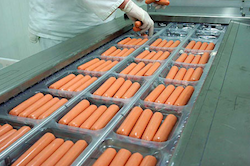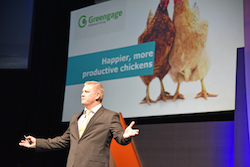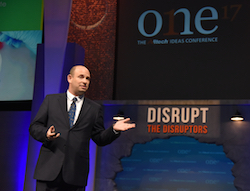National Dairy FARM’s 2017 Evaluator Conference
 The second annual National Dairy FARM Program Evaluator Conference will be held in Indianapolis, Ind., from July 18-19. More than 400 certified FARM Program evaluators will have the chance to network and discuss relevant topics in animal care, environmental stewardship and antibiotic stewardship.
The second annual National Dairy FARM Program Evaluator Conference will be held in Indianapolis, Ind., from July 18-19. More than 400 certified FARM Program evaluators will have the chance to network and discuss relevant topics in animal care, environmental stewardship and antibiotic stewardship.
FARM evaluators will spend a day with Elanco staff, focusing on professional development and learning more about Elanco’s global business of feeding a growing population. Attendees will also experience a full day of programming, including presentations on “The Economics of Animal Well-Being,” as well as insight from a panel of farmers and veterinarians on the importance of protocol development and employee training.
“We are excited to host a dedicated group of FARM evaluators for what will be three full days of enlightening conversation and learning,” said Emily Meredith, chief of staff for the National Milk Producers Federation. “Nurturing strong relationships among members of the animal care community will only enhance our ability to share the industry’s great story of top-notch animal care.”
Sponsors include Elanco, Zoetis and Merck Animal Health.
Land O’Lakes, Inc. Dairy Accelerator Program
 Land O’Lakes, Inc. has launched its Land O’Lakes Dairy Accelerator, a program that will provide support and mentorship to food entrepreneurs who want to grow and drive innovation in the dairy products space.
Land O’Lakes, Inc. has launched its Land O’Lakes Dairy Accelerator, a program that will provide support and mentorship to food entrepreneurs who want to grow and drive innovation in the dairy products space.
“Land O’Lakes, Inc. was founded on innovation by the original entrepreneurs—farmers,” said Raquel Melo, vice president of Innovation and New Business Development at Land O’Lakes, Inc. “By launching the Dairy Accelerator program, we commit to fostering continued growth in the dairy industry by supporting entrepreneurs and assisting their efforts to bring new dairy companies to the next level.”
The Land O’Lakes Dairy Accelerator is looking for U.S.-based entrepreneurs passionate about moving their companies to the next level. The company must utilize dairy as a primary ingredient but can use any aspect of dairy including but not limited to: yogurt, cheese, whey or other milk-based proteins or ingredients. However, new innovations cannot focus on butter. Eligible companies should have sales of approximately $200,000 over the last 12 months.
Bringing Smart Farming to Aquaculture
 Farmers across the livestock production sectors have begun to have increased access to smart farming technology on their operations, including the booming global aquaculture industry. Rully Setya Purnama is the Chief Operating Officer of eFishery, a company offering integrated feeding solution for fish and shrimp farming that allows operators to control their fish/shrimp feeding performance directly from a smartphone or laptop, anytime and anywhere. He sat down with Jamie Johansen at ONE: The Alltech Ideas Conference, where he finished up his participation with the Pearse Lyons Accelerator Program, to talk about eFishery’s innovations and how they are revolutionizing the Asian fish market.
Farmers across the livestock production sectors have begun to have increased access to smart farming technology on their operations, including the booming global aquaculture industry. Rully Setya Purnama is the Chief Operating Officer of eFishery, a company offering integrated feeding solution for fish and shrimp farming that allows operators to control their fish/shrimp feeding performance directly from a smartphone or laptop, anytime and anywhere. He sat down with Jamie Johansen at ONE: The Alltech Ideas Conference, where he finished up his participation with the Pearse Lyons Accelerator Program, to talk about eFishery’s innovations and how they are revolutionizing the Asian fish market.
“Our technology uses sensors that can monitor the appetite of fish and shrimp in real-time and report data back to operators, making feeding more efficient, reducing feeding costs up to 31% and boosting profits up to 100%,” said Purnama. “And it’s all connected to the cloud, so every farmer can access their business remotely, anytime and anywhere.”
Alltech has opened global opportunities for eFishery, and the company is currently operating in the world’s six largest aquaculture producers: Indonesia, Bangladesh, Thailand, Vietnam, China, and India. Purnama hopes to continue expanding the company throughout the large Asian fish market and, eventually, throughout the entire global market.
Listen to Jamie’s full interview with Rully here:
Interview with Rully Setya Purnama, eFishery
Download photos from the event here:
Alltech ONE17 Photo Album
Season of 7 Billion Hot Dogs Begins
 The National Hot Dog and Sausage Council (NHDSC) estimates that Americans will eat 7 billion hot dogs during this year’s grilling season which runs from Memorial Day weekend through Labor Day. That’s 818 hot dogs per second and more than a third of the hot dogs eaten per year.
The National Hot Dog and Sausage Council (NHDSC) estimates that Americans will eat 7 billion hot dogs during this year’s grilling season which runs from Memorial Day weekend through Labor Day. That’s 818 hot dogs per second and more than a third of the hot dogs eaten per year.
New research commissioned by the NHDSC and conducted online by Harris Poll finds that 72 percent of Americans say that the true ingredients of a hot dog are a mystery to them despite popularity and that ingredients are listed on package.
The same research found on average Americans estimate that a standard hot dog contains 210 calories, while 41 percent of Americans say that they do not know. While calories vary by brand, USDA says the average standard beef hot dog contains just 154 calories.
The NHDSC has developed several resources to help address these misperceptions. A recently released guide to hot dog ingredients allows people to search for the ingredients listed on a hot dog package and learn more about what those ingredients are and why they are used. A new hot dog and sausage nutrition guide will debut this summer and here’s a video showing the full process of how hot dogs are made.
Lighting Up Poultry Production With LED Sensors
 Steve Parsons has been a part of the chicken industry throughout his entire life, and his company, Greengage Lighting Ltd, is using LED systems to help poultry and swine farmers further improve the efficiency and productivity of their operations. Parsons sat down with Jamie Johansen during ONE: The Alltech Ideas Conference, where he gave a presentation on his company through his participation in the Pearse Lyons Accelerator Program.
Steve Parsons has been a part of the chicken industry throughout his entire life, and his company, Greengage Lighting Ltd, is using LED systems to help poultry and swine farmers further improve the efficiency and productivity of their operations. Parsons sat down with Jamie Johansen during ONE: The Alltech Ideas Conference, where he gave a presentation on his company through his participation in the Pearse Lyons Accelerator Program.
Greengage supplies an induction-powered system that makes LED lights and sensors for poultry and swine. It uses patented inductive technology, a magnetic conductive system that converts energy into LED lights on a wave spectrum that has been aligned to the requirements of a chicken.
“We try to replicate sunlight and give the birds the best natural behavior for performance and welfare,” said Parsons. “Lighting has been a bit of a forgotten requirement, the focus has been turned to food, water, and air, but sunlight offers so many benefits, so what we’re trying to do is take the natural phenomena of sunlight and drive that benefit into growing chickens.”
Listen to Jamie’s full interview with Steve here:
Interview with Steve Parson, Greengage Lighting Ltd
Download photos from the event here:
Alltech ONE17 Photo Album
Aptimmune Adds Sales Veterans to its Swine Team
 Aptimmune announces the addition of three new strategic account managers to the company’s swine division focusing on the new Aptimmune autogenous PRRS vaccine made with BARRICADE® technology. They will also help grow the Aptimmune portfolio of swine vaccines and augment the company’s sales organization with experienced swine industry professionals.
Aptimmune announces the addition of three new strategic account managers to the company’s swine division focusing on the new Aptimmune autogenous PRRS vaccine made with BARRICADE® technology. They will also help grow the Aptimmune portfolio of swine vaccines and augment the company’s sales organization with experienced swine industry professionals.
Joining Aptimmune this month are Andy Wuethrich, Brian Konz and Andy Smythe.
Andy Wuethrich has more than 23 years of experience in agriculture, split between animal health and grain merchandising. Prior to joining Aptimmune, he worked for several animal health companies, including Elanco Animal Health. He holds a Bachelor of Science degree in agriculture from Purdue University.
Wuethrich will assist in the development and implementation of comprehensive sales strategies. He will partner with Aptimmune Technical Services in supporting customer initiatives and manage relationships with designated key account partners.
“Andy has a deep, broad level of agriculture and animal health knowledge and a proven track record for exceptional sales and service to swine producers. He will be a tremendous asset to Aptimmune and to our sales team,” says Aaron Gilbertie, CEO, Aptimmune Biologics.
USFRA Promotes Agricultural Sustainability at Conference
 The U.S. Farmers and Ranchers Alliance® (USFRA®) is at the Sustainable Brands Conference in Detroit this week to showcase the sustainability of farmers and ranchers and unveil the first-ever Agriculture in America Sustainability Report.
The U.S. Farmers and Ranchers Alliance® (USFRA®) is at the Sustainable Brands Conference in Detroit this week to showcase the sustainability of farmers and ranchers and unveil the first-ever Agriculture in America Sustainability Report.
The sustainability report builds on key insights from USFRA’s annual research that aims to identify and gain a clearer understanding of consumers’ perception of sustainability in U.S. food and agriculture. Through this research, findings conclude that consumers struggle to define sustainability. Moreover, the topic is best understood by consumers when farmers explain the tangible ways they are improving the water, soil, air and habitat on and around their farms.
USFRA is engaging attendees at the national event for brand leaders “who create environmental and social purpose to drive innovation” with the SMART Farm booth, allowing event goers to experience USFRA’s 360-degree videos highlighting how farmers use new technologies to enhance animal welfare, efficiency and sustainability.
Real smart farmers are also on hand to talk about modern food production. USFRA Chairman Brad Greenway of South Dakota and CommonGround volunteer Hilary Maricle of Nebraska, both crop and livestock farmers, are presenting at the conference about raising farm animals humanely, environmentally-sustainably, and profitably.
Feeding the World with Grasshopper Protein
 When Dror Tamir founded Hargol Food Tech, he named it after the Hebrew word for grasshopper, and that isn’t a coincidence. The company, which develops solutions to combat global malnutrition and food insecurity, is pioneering the production and processing of grasshopper-based protein sources. Tamir sat down with our Jamie Johansen during ONE: The Alltech Ideas Conference to discuss his unique approach to achieving global food security and highlight the presentation he gave during the event as part of his involvement with the Pearse Lyons Accelerator Program.
When Dror Tamir founded Hargol Food Tech, he named it after the Hebrew word for grasshopper, and that isn’t a coincidence. The company, which develops solutions to combat global malnutrition and food insecurity, is pioneering the production and processing of grasshopper-based protein sources. Tamir sat down with our Jamie Johansen during ONE: The Alltech Ideas Conference to discuss his unique approach to achieving global food security and highlight the presentation he gave during the event as part of his involvement with the Pearse Lyons Accelerator Program.
Tamir explained that the vision for Hargol came to life upon learning that the global demand for protein is increasing rapidly, with estimates that the demand could double by 2050. Grasshoppers, he believes, can help meet the growing demand without the environmental and nutritional limitations facing the animal and plant-based protein sources that are common in traditional western diets.
“There is very high demand for alternative protein and grasshoppers are best suited to meet that demand,” said Tamir. “They provide an amazing nutritional profile with over 72% protein, a complete profile of essential amino acids, and no saturated fats.”
Finding a way to pitch grasshopper protein as an acceptable idea to skeptical western populations has been a major part of the company’s development. His solution only requires some simple food processing: Tamir plans to market a milled grasshopper protein powder. Grasshoppers are neutral in taste and flavor, allowing food companies to easily use the milled grasshopper protein as an additive to products like protein shakes, energy bars, pasta sauce, and even baked goods.
“This isn’t a new development by any means, this is a concept humans have utilized throughout history, and it is a concept that should resonate with supporters of the paleo diet,” said Tamir. “About half of the current world population consumes insects as part of their diet and grasshoppers are the most widely eaten insect in the world. They are in very high demand in South America, the Middle East, and Asia, what we are doing is pioneering the ability to grow them commercially.”
Listen to Jamie’s full interview with Dror here:
Interview with Dror Tamir, Hargol Food Tech
Download photos from the event here:
Alltech ONE17 Photo Album
Congress Hears Testimony on Regulatory Burdens
 Two beef industry representatives testified before multiple U.S. House of Representatives committees regarding the need to alleviate the regulatory burden faced by ranchers working on public lands. Arizona rancher David Cook gave his testimony on the Federal Land Policy and Management Act (FLPMA) and the Wilderness Act before the U.S. House Natural Resources Subcommittee on Oversight and Investigations, and Darcy Helmick, Land Manager for Simplot Land & Livestock, testified before the House Committee on Oversight and Government Reform, Subcommittee on Intergovernmental Affairs and Subcommittee on the Interior, Energy, and Environment.
Two beef industry representatives testified before multiple U.S. House of Representatives committees regarding the need to alleviate the regulatory burden faced by ranchers working on public lands. Arizona rancher David Cook gave his testimony on the Federal Land Policy and Management Act (FLPMA) and the Wilderness Act before the U.S. House Natural Resources Subcommittee on Oversight and Investigations, and Darcy Helmick, Land Manager for Simplot Land & Livestock, testified before the House Committee on Oversight and Government Reform, Subcommittee on Intergovernmental Affairs and Subcommittee on the Interior, Energy, and Environment.
Helmick’s testimony addressed the way environmental advocacy groups and federal agencies regulate through consent decrees using citizen lawsuit provisions in environmental laws, a practice known as “sue and settle.”
 “In my extensive experience dealing with the federal grazing system and western land use in general, offensive litigation tactics by outside activist groups have served to totally derail business operations,” said Helmick. “While it is critical that we maintain the right of citizens to litigate when necessary, reform is needed to prevent that right from being abused or exploited.”
“In my extensive experience dealing with the federal grazing system and western land use in general, offensive litigation tactics by outside activist groups have served to totally derail business operations,” said Helmick. “While it is critical that we maintain the right of citizens to litigate when necessary, reform is needed to prevent that right from being abused or exploited.”
In his testimony on FLPMA, Cook explained that, while FLPMA and the Wilderness Act were enacted with the intent to provide direction for the management of public lands, the delegation of authority from Congress to the land management agencies has resulted in unchecked, abused authority over land-use planning by administrators.
“I do not believe it was the intent of Congress to disenfranchise communities like mine when laws like FLPMA and the Wilderness Act were originally enacted, but that is certainly where we have ended up,” explained Cook. “The burden of compliance with these processes – not to mention the struggle to have our voice as a stakeholder heard and respected has become the dominant consumer of time and resources for anyone or any entity interacting with federally-managed lands.”

